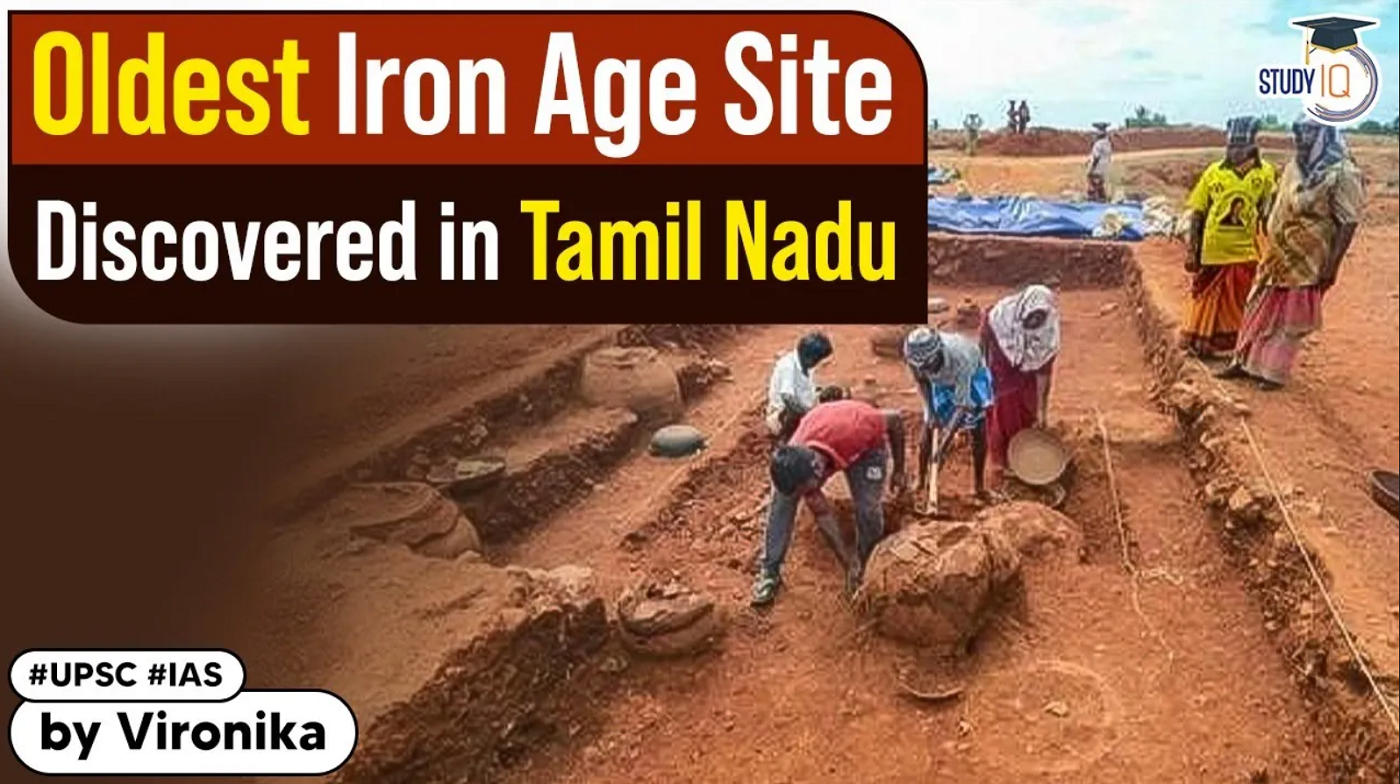Table of Contents
- Carbon dating of excavated finds in Tamil Nadu pushes evidence of iron being used in India back to 4,200 years ago, the Tamil Nadu government announced this week on the basis of an archaeological report.

- Before this, the earliest evidence of iron use was from 1900-2000 BCE for the country, and from 1500 BCE for Tamil Nadu.
- The latest evidence dates the findings from Tamil Nadu to 2172 BCE.
- It has been established that Tamils who lived 4,200 years ago were aware of iron.
- Dense forests were converted into fertile lands only after humankind began realising the use of iron.
- This finding has answered questions relating to the start of agricultural activity in Tamil Nadu.
The findings
- The excavations are from Mayiladumparai near Krishnagiri in Tamil Nadu, about 100 km south of Bengaluru.
- Mayiladumparai is an important site with cultural material dating back between the Microlithic (30,000 BCE) and Early Historic (600 BCE) ages.

- “The site is situated in the midst of several archaeological sites such as Togarapalli, Gangavaram, Sandur, Vedarthattakkal, Guttur, Gidlur, Sappamutlu and Kappalavadi…
- All these important archaeological sites lie within 10 km,” said the report cited by Stalin, titled ‘Mayiladumparai: Beginning of Agrarian Society 4200 years old Iron Age culture in Tamilnadu’, and headed by archaeologist K Rajan.
- Prof Rajan had discovered the site in the 1990s, and the first excavations from there were made in the 1990s. The results of dating, which used accelerator mass spectroscopy, came last week.
Timeline revisited
- The dates when humans entered the Iron Age vary from one region of the world to another. In India, too, the date has been revised with successive findings over the decades.
- In 1979, use of iron was traced to 1300 BCE at Ahar in Rajasthan. Later, samples at Bukkasagara in Karnataka, indicating iron production, were dated back to 1530 BCE.
- The date was subsequently pushed back to 1700-1800 BCE with excavations finding evidence of iron smelting at Raipura in the Mid-Ganga valley, and then to 1900-2000 BCE based on investigations in sites at Malhar near Varanasi and Brahmagiri in North Karnataka.
- A series of dating results on finds from various parts in India have shown evidence of iron-ore technology before 1800 BCE.
- Before the latest discovery, the earliest evidence of iron use for Tamil Nadu was from Thelunganur and Mangadu near Mettur, dating back to 1500 BCE.
Historical significance
- Iron is not known to have been used in the Indus Valley, from where the use of copper in India is said to have originated (1500 BCE).
- While useful tools were made out of copper, these were brittle and not as strong as iron tools would be.
- It would have been difficult to use copper tools to clear dense forests and bring land under agriculture — which is why scientists infer that deforestation took place only after humans began using iron.
- And the benefit of socio-economic changes and massive production triggered by the iron technology gave its first fruit around 600 BCE — the Tamil Brahmi scripts.
Culture and Politics
- The Tamil Brahmi scripts were once believed to have originated around 300 BCE, until a landmark finding in 2019 pushed the date back to 600 BCE.
- This dating narrowed the gap between the Indus Valley civilisation and Tamilagam/South India’s Sangam Age. This, and the latest findings, are politically significant.
- The dating of the scripts, based on excavations from sites including Keeladi near Madurai, became controversial when the Archaeological Survey of India (ASI) did not go for advanced carbon dating tests, and an ASI researcher who had initiated the study was transferred out of the state. The 2019 findings came out of the state government’s efforts.
Iron Age
- The Iron Age in the Indian subcontinent was the one succeeding the Late Harappan Culture. The period is known because of the material of tools used in the time frame.
- The era coincides with the Vedic Age in the historical timeline.
- It is associated with Indo-Aryan people and also saw the emergence of Buddhism and Jainism.
- Painted Grey Ware and the Northern Black Polished Ware were the prominent cultures of the era.
- The era saw the major settlement of the time concentrating towards the eastern side from the Sapta-Sindhu region which was in the west.
- The earliest Iron Age sites in South India are Malhar in Uttar Pradesh, Hallur and Brahmagiri in Karnataka.




Question:
Rice was first grown at which of the following places?
- Narmada Valley
- Indus Valley
- Garo Hills
- North of Vindhyas
Latest Burning Issues | Free PDF
























 WhatsApp
WhatsApp